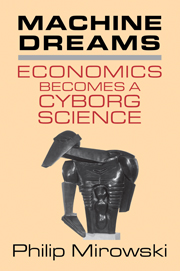Book contents
- Frontmatter
- Contents
- List of Figures and Tables
- Acknowledgments
- List of Abbreviations
- 1 Cyborg Agonistes
- 2 Some Cyborg Genealogies; or, How the Demon Got Its Bots
- 3 John von Neumann and the Cyborg Incursion into Economics
- 4 The Military, the Scientists, and the Revised Rules of the Game
- 5 Do Cyborgs Dream of Efficient Markets?
- 6 The Empire Strikes Back
- 7 Core Wars
- 8 Machines Who Think versus Machines That Sell
- Envoi
- References
- Index
6 - The Empire Strikes Back
Published online by Cambridge University Press: 05 June 2012
- Frontmatter
- Contents
- List of Figures and Tables
- Acknowledgments
- List of Abbreviations
- 1 Cyborg Agonistes
- 2 Some Cyborg Genealogies; or, How the Demon Got Its Bots
- 3 John von Neumann and the Cyborg Incursion into Economics
- 4 The Military, the Scientists, and the Revised Rules of the Game
- 5 Do Cyborgs Dream of Efficient Markets?
- 6 The Empire Strikes Back
- 7 Core Wars
- 8 Machines Who Think versus Machines That Sell
- Envoi
- References
- Index
Summary
I'd like to think that computers are neutral, a tool like any other, a hammer that could build a hose or smash a skull. But there is something in the system itself, in the formal logic of data and programs, that recreates the world in its own image…. It is as if we took the game of chess and declared it the highest order of human existence.
Ellen Ullman, Close to the MachinePREVIEWS OF CUNNING ABSTRACTIONS
What did it mean to set out to construct a cyborg around 1950 in America? We are not talking engineering specs here, although it should go without saying that everything, hardware included, matters when it comes to easing into the American cybernetical sublime. It was a further testimonial to the planned science regime of World War II that the immediate postwar era found itself awash in auspicious gizmos. The transistor was invented in 1947 at Bell Labs; magnetic disk storage was implemented at the National Bureau of Standards in 1951; the first magnetic durm memory was installed in a computer for, the lineal predecessor of the National Security Agency in 1950 (Bamford, 1982, p. 99); magnetic core memories were innovated at Project Whirlwind at MIT in the early 1950s.
Information
- Type
- Chapter
- Information
- Machine DreamsEconomics Becomes a Cyborg Science, pp. 309 - 436Publisher: Cambridge University PressPrint publication year: 2001
